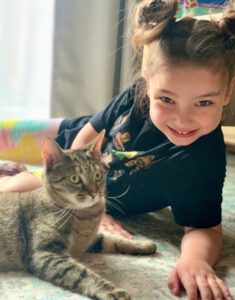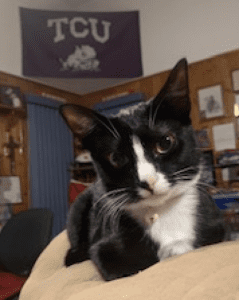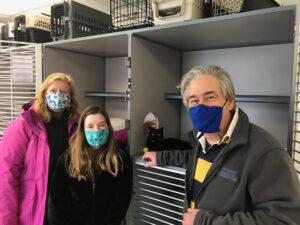 At a time when we were forced to stay home more, forced to spend more time with our nuclear families and forced to figure out how we could make ourselves happy without a lot of outside influence, the past 15 months of the pandemic helped many come to the realization that it was primetime to bring home a pet. The unconditional love and companionship of pets brought happiness and positivity into an otherwise difficult year. And pets, too, benefitted from loving homes and opportunities they might have waited much longer for.
At a time when we were forced to stay home more, forced to spend more time with our nuclear families and forced to figure out how we could make ourselves happy without a lot of outside influence, the past 15 months of the pandemic helped many come to the realization that it was primetime to bring home a pet. The unconditional love and companionship of pets brought happiness and positivity into an otherwise difficult year. And pets, too, benefitted from loving homes and opportunities they might have waited much longer for.
EVERYONE WANTS A PET
Whether it was the opportunity to be home and have more time for walking and playing, a chance to be around to ensure proper feeding and grooming, or simply a need to have another friend around, the “pandemic pet” craze became a reality around the country and here in Princeton. This craze brings with it lots of love and joy, and also a lot to think about.
 “In mid-March [2020], as soon as the Governor of New Jersey put the stay-at-home order in place, which was supposed to be two weeks, we started to see this uptick. When it was extended past the two weeks, it completely was doubling, tripling, quadrupling our applications,” recalls Heather Achenbach, Executive Director of SAVE animal shelter in Skillman. “Once people thought it was continuing, realizing they totally could get a pet – the longer it went, the more of a frenzy it became.”
“In mid-March [2020], as soon as the Governor of New Jersey put the stay-at-home order in place, which was supposed to be two weeks, we started to see this uptick. When it was extended past the two weeks, it completely was doubling, tripling, quadrupling our applications,” recalls Heather Achenbach, Executive Director of SAVE animal shelter in Skillman. “Once people thought it was continuing, realizing they totally could get a pet – the longer it went, the more of a frenzy it became.”
Adopting a pet to permanently live with you and join your family is a big commitment. And that was the right decision for many. For others, who weren’t yet sure or who simply needed temporary companionship, fostering was a better option. Kim Callea, Assistant Manager at EASEL animal rescue league in Ewing, shares how this choice became extremely popular.
“EASEL’s fostering network on the dog team exploded in the best way possible, and we at one point had more dogs in foster than cats (which has never happened in my 5 years of being here). More people were home, therefore they had the time to foster. Many wanted to help, but not make the commitment to adopting, so fostering was a great opportunity.”
Dogs were not the only pet of choice. Cats, which were adopted 50% more at EASEL in 2020 than 2019, saw a significant increase in fostering, too.
“Our cat foster applications went up significantly and our capacity doubled. This was especially important during “Kitten Season” from May through October,” explains Barbara Amideneau, EASEL Cat Foster Coordinator. “We had more families who were not traveling for summer vacation wanting to foster during that critical time.”
At Princeton Animal Hospital, last summer also brought in four times the number of new patients, with 160 new pets coming in each month compared to an average of 30-40 monthly prior to the pandemic.

“At a time where people may feel lost and alone due to the isolation, adding a furry companion can be great for mental health!” notes Princeton Animal Hospital Practice Manager, Allie Whartenby.
In fact, 90% of respondents in a recent study out of the UK said their pet helped them cope emotionally during the lockdown. While dogs and cats were most popular, the study showed that emotional bonds with all kinds of animals showed equal benefits. This could explain why purchases of fish, reptiles, birds and hamsters also grew dramatically this past year.
PET FAMILIES, THE PROS AND CONS
The Evans family, which has lived in Princeton for over 19 years, hasn’t had a pet since 2003. That all changed this year, when family dynamics and the yearning for a furry friend won out.
“A pet is something we’ve talked about on and off for years,” explains Sue Evans. “This past fall, our middle daughter moved to college in Texas and our oldest started a full-time job in Texas. That meant our youngest daughter was home without her sisters. The house was super quiet and felt empty. My oldest started fostering a kitten in October, and we all fell in love (long distance). They both came home from November to January, and we decided we really needed a kitten.”
 Loki, a tuxedo kitten named for their favorite Marvel character, was adopted from SAVE and became an instant part of the family. And it’s been easy, as currently there is always someone at home to provide care and attention. This timing also created an unintended consequence as Loki became largely unaccustomed to strangers.
Loki, a tuxedo kitten named for their favorite Marvel character, was adopted from SAVE and became an instant part of the family. And it’s been easy, as currently there is always someone at home to provide care and attention. This timing also created an unintended consequence as Loki became largely unaccustomed to strangers.
“Since we got her during a time of limited visitors, she does NOT like other people. She gave my middle daughter a lot of attitude when she came home from school a few weeks ago – won’t go near her, doesn’t let her pet her, runs away when she sees her. If someone comes over, Loki hides – she is not a people person,” states Evans.
The fast and furious swarms of interest at shelters, stores and breeders also brought about other unintended consequences. The northeastern U.S. is a very popular area for pet ownership and an area where many other states send their animals, because we don’t have the homeless pet issues that occur down south. SAVE, for example, gets regular deliveries of animals from Tennessee, yet could not find anyone to drive transport last year for fear of contracting COVID-19. This limited the number of animals available there for adoption.
“We emptied ourselves of dogs more times than I can count. I think it was 4 or 5 times. Literally, no adoptable dogs,” recalls Achenbach.
Local breeders encountered a similar flurry of demand and could not keep up. According to Patricia Hess of Bella Pups, a Pennington-based breeder of golden retrievers and goldendoodles for over 20 years, dogs only have two heats a year and it’s recommended they only produce a litter once annually. This puts limits on how many dogs a good breeder can have available. Yet, it didn’t stop people from trying.
“We were flooded. I literally had to take my phone number and email off the website for a time, I couldn’t keep up with it,” shares Hess, whose breed makes for very intelligent and desirable pets.
While many had to travel far and wide to find specific breeds, luck was on the side of the Levine family, who felt getting a dog from a breeder was their only choice due to asthma and allergies in the family. Their need for a non-shedding dog and their love for doodles led them to find a breed called labradoodle (a cross between a Labrador retriever and a poodle) from a breeder in nearby Bucks County, PA.
 “We were fortunate that someone on the waitlist backed out and we got their slot, we only waited 8 weeks. We would have had to wait at least 6 months otherwise,” states Dana Levine, who lives in Princeton with her husband and two children.
“We were fortunate that someone on the waitlist backed out and we got their slot, we only waited 8 weeks. We would have had to wait at least 6 months otherwise,” states Dana Levine, who lives in Princeton with her husband and two children.
The Levines both work full-time jobs, so they had been hesitant to respond to their children’s pleas for a dog. But the pandemic’s work-from-home situation led them to rethink things. The house may not be as clean these days and there are earlier wake-up calls, but their mini-labradoodle, Tony Pickles, is a welcomed addition to the family.
“We’re beyond happy. Tony has brought endless love to the Levine household. Additionally, I’ve met new friends who also have dogs in my neighborhood because of him,” says Levine.
SUPPLY AND DEMAND
The difficulty of finding a dog at a breeder led many to turn to shelter and rescue pets, which was great for those dogs and cats. After 15 months, they are all seeing things slow down from the frantic pace of last summer.
“I think the pendulum has swung in the other direction now. Everything has opened back up and I think people are saying let’s not get a dog now and enjoy the summer,” Hess adds.
While that may be the case, the drastic increase in dog and cat ownership this past year combined with supply chain and manufacturing delays has created shortages in dog and cat food. It’s also meant some other desirable pets are not available.
 PetSmart on Nassau Park Boulevard has been selling a lot of fish and hamsters this year. Parakeets and other birds have also become extremely popular.
PetSmart on Nassau Park Boulevard has been selling a lot of fish and hamsters this year. Parakeets and other birds have also become extremely popular.
“From what we’ve been seeing in the last few weeks, there seems to be a vendor shortage where they can’t keep up with the demand for a lot of animals and a lot of fish as well. We can’t even keep certain animals in stock,” explains Adam Oestreicher, PetSmart Manager.
The pet store thought a lot of people wouldn’t be shopping when the initial lockdown occurred, but pets need supplies and food. So, the store never closed down, which was a bit overwhelming for the staff.
T&T Pet Supply in Skillman similarly saw its busiest season ever when the pandemic hit. 80% of their business at the time shifted to deliveries.
“When it first happened, I was doing deliveries left and right, we were already set up for it,” remembers T&T Pet Supply owner, Mark Hunsbedt. “It got so busy we had to go out and get a van!”
EMOTIONAL UPS AND DOWNS
Adapting and quick changes were the reality for everyone in the pet business. Whether selling animals or the things they need, breeding or providing animals for fostering or adoption, those in charge had to learn quickly what worked and what didn’t. Families wanted to bring home pets, but new caretakers don’t always know what’s the right fit.
“We were getting returned puppies, families that thought they were ready then realized they were so stressed from the pandemic and having kids home, instead of the pet helping, it was causing more stress,” Achenbach explains.
 And stress isn’t just something that humans can feel. As our world opens back up and people begin to spend less time at home, it is important to adjust your pets to their new reality and keep them from feeling overwhelmed.
And stress isn’t just something that humans can feel. As our world opens back up and people begin to spend less time at home, it is important to adjust your pets to their new reality and keep them from feeling overwhelmed.
“Separation anxiety in pets is something we frequently see in patients which results in damage or destruction of the home, excessive barking or nervousness, and inappropriate bathroom habits when families leave the pet at home,” explains Whartenby. “Taking steps prior to being faced with a change to prepare your pet is important to minimize their anxiety.”
How does one do this? Before you leave for long stretches, it is suggested that you help your pet get used to you not being around by leaving them for brief periods of time. You may want to summon the help of a dog trainer to help them adjust and reduce anxiety. Whartenby also suggests utilizing items such as Kong toys that can reduce boredom while your pet is alone and to absolutely ensure the environment you leave them in is a safe one.
To date, SAVE says it has not had a single pet returned due to separation anxiety as their families return to school and work. But while you do still have a bit more time at home, it’s also great to get your pets outside with others.
“Continuing to socialize their adopted dogs is crucial. Now that restrictions are being lifted, it is important to get your pup out there and meeting new people. Summer is quickly approaching which means warm weather and sunshine – so get your dogs moving!” adds Dr. Georgia Arvanitis, EASEL VP, Director of Grants. “Similarly, for cats and kittens, they need to be introduced to people outside your immediate family, so that they are not ‘fraidy cats.’ They need to be comfortable with guests, and not run and hide when the doorbell rings!”
STILL WANT A PET?
 If you haven’t yet brought home your pandemic pet, it’s important to consider the reasons you want one– are they fleeting or permanent? Our experts have some advice to guide you towards the right pet.
If you haven’t yet brought home your pandemic pet, it’s important to consider the reasons you want one– are they fleeting or permanent? Our experts have some advice to guide you towards the right pet.
“Take a pet off the table if you can’t provide for it financially, give your pet the time it needs, those are the two primary commitments. You also need patience. If you don’t have those 3 things, do not get a pet. It’s that simple,” suggests Achenbach.
The life expectancy of dogs is 10-12 years and for cats it is 12-15 years, so think ahead about how many years to are able to commit for. It is also important to decide if you want or need a certain breed. Stores, shelters and rescues are great options but if you choose to seek out a breeder, do your research.
“If you can get a puppy tomorrow, that’s questionable. They should make sure they’re going to a breeder they’ve been referred to, that actually exists. A lot of people told me they were scammed,” recalls Hess.
Breeders should invite you to their home or place of work, so you can see and meet the dogs. Hess says if they suggest a different meeting spot or an odd form of payment, you should question the situation. And be patient, as a good breeder doesn’t always have a dog immediately available.
Patience is also essential when visiting your veterinarian. In addition to seeing more pets, this past year saw a shortage of veterinary graduates applying for jobs – so the clinics are short staffed!
 The stores where you may get supplies and food, they are short staffed, too. And busy as ever – only more people are coming on site rather than requesting deliveries.
The stores where you may get supplies and food, they are short staffed, too. And busy as ever – only more people are coming on site rather than requesting deliveries.
In the end, have patience for your pets. They, too, will be adjusting to a new normal as the world opens up more and more. But enjoy them. Thankfully the pandemic pet craze has brought more unconditional love and affection into people’s homes than ever before.

Lisa Jacknow spent years working in national and local news in and around New York City before moving to Princeton. Working as both a TV producer and news reporter, Lisa came to this area to focus on the local news of Mercer County at WZBN-TV. In recent years, she got immersed in the Princeton community by serving leadership roles at local schools in addition to volunteering for other local non-profits. In her free time, Lisa loves to spend time with her family, play tennis, sing and play the piano. A graduate of the S. I. Newhouse School of Public Communications at Syracuse University, Lisa was raised just north of Boston, Massachusetts but has lived in the tri-state area since college. She is excited to be Editor and head writer for Princeton Perspectives!
